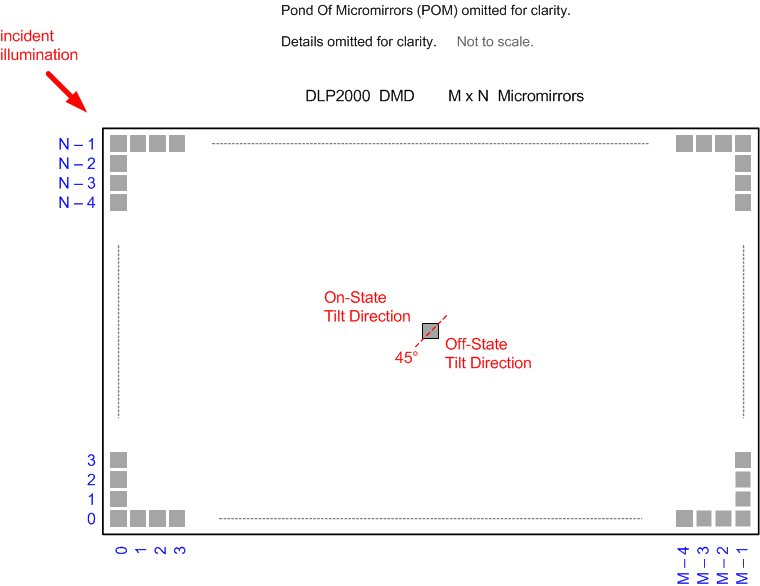DLPS140B March 2019 – May 2022 DLP2000
PRODUCTION DATA
- 1 Features
- 2 Applications
- 3 Description
- 4 Revision History
- 5 Pin Configuration and Functions
-
6 Specifications
- 6.1 Absolute Maximum Ratings
- 6.2 Storage Conditions
- 6.3 ESD Ratings
- 6.4 Recommended Operating Conditions
- 6.5 Thermal Information
- 6.6 Electrical Characteristics
- 6.7 Timing Requirements
- 6.8 System Mounting Interface Loads
- 6.9 Physical Characteristics of the Micromirror Array
- 6.10 Micromirror Array Optical Characteristics
- 6.11 Window Characteristics
- 6.12 Chipset Component Usage Specification
- 7 Detailed Description
- 8 Application and Implementation
- 9 Power Supply Recommendations
- 10Layout
- 11Device and Documentation Support
- 12Mechanical, Packaging, and Orderable Information
Package Options
Mechanical Data (Package|Pins)
- FQC|42
Thermal pad, mechanical data (Package|Pins)
Orderable Information
6.10 Micromirror Array Optical Characteristics
| PARAMETER | TEST CONDITIONS | MIN | NOM | MAX | UNIT | |
|---|---|---|---|---|---|---|
| Micromirror tilt—half angle, variation device to device (1) | 11 | 12 | 13 | ° | ||
| Axis of rotation with respect to system datums, variation device to device(2) | 44 | 45 | 46 | ° | ||
| Image performance(3) | Bright pixel(s) in active area(4) | Gray 10 screen(5) | 0 | micromirrors | ||
| Bright pixel(s) in the POM(6) | Gray 10 screen(5) | 1 | ||||
| Dark pixel(s) in the active area(7) | White screen | 4 | ||||
| Adjacent pixel(s)(8) | Any screen | 0 | ||||
| Unstable pixel(s) in active area(9) | Any screen | 0 | ||||
(1) Limits on variability of micromirror tilt half angle are
critical in the design of the accompanying optical system. Variations in tilt
angle within a device may result in apparent non-uniformities, such as line
pairing and image mottling, across the projected image. Variations in the
average tilt angle between devices may result in colorimetry and system contrast
variations. The specified limits represent the tolerances of the tilt angles
within a device.
(2) See Figure 6-9.
(3) Conditions of
acceptance:
All DMD image quality returns
are
evaluated using the following projected image test conditions:
Test set degamma should be linear.
Test set brightness and contrast should be set to nominal.
The diagonal size of the projected image should be a minimum of 20 inches.
The projections screen should be 1X gain.
The projected image should be inspected from a 38-inch minimum viewing distance.
The image should be in focus during all image quality tests.
Test set degamma should be linear.
Test set brightness and contrast should be set to nominal.
The diagonal size of the projected image should be a minimum of 20 inches.
The projections screen should be 1X gain.
The projected image should be inspected from a 38-inch minimum viewing distance.
The image should be in focus during all image quality tests.
(4) Bright pixel definition: A single
pixel or mirror that is stuck in the ON position and is visibly brighter than
the surrounding pixels
(5) Gray 10 screen definition: All
areas of the screen are colored with the following settings:
Red = 10/255
Green = 10/255
Blue = 10/255
Red = 10/255
Green = 10/255
Blue = 10/255
(6) POM definition: Rectangular
border of off-state mirrors surrounding the active area
(7) Dark pixel definition: A single
pixel or mirror that is stuck in the OFF position and is visibly darker than the
surrounding pixels
(8) Adjacent pixel definition: Two or
more stuck pixels sharing a common border or common point, also referred to as a
cluster
(9) Unstable pixel definition: A
single pixel or mirror that does not operate in sequence with parameters loaded
into memory. The unstable pixel appears to be flickering asynchronously with the
image.
 Figure 6-9 Landed
Pixel Orientation and Tilt
Figure 6-9 Landed
Pixel Orientation and TiltSee Section 6.9 for M and N specifications.